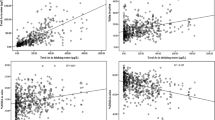Abstract
The capacity for inorganic arsenic (ASi) methylation in 13 healthy volunteers and in 30 patients with different types of liver disease has been assessed by measuring the amount of unmetabolized Asi, monomethylarsonic acid (MMA) and dimethylarsinic acid (DMA) excreted in urine within 24 h after the IV injection of 7.14 μg/kg ASi. Liver disease does not affect the percent of the injected dose excreted within 24 h but has striking and opposite effects on the proportions of MMA and DMA. MMA excretion is highly correlated with the 14C-aminopyrine breath test (r=0.73; P<0.05). The reduction in the proportion of MMA excreted in urine and the increase in that of DMA are similar with regard to sensitivity and specificity for detecting liver impairment. Unlike the 14C-aminopyrine breath test, the inorganic arsenic methylation test offers the advantage of being unaffected by treatment with microsomal enzyme inducers.
Similar content being viewed by others
References
Buchet JP, Lauwerys R, Roels H (1980) Comparison of several methods for the determination of arsenic compounds in water and in urine. Int Arch Occup Environ Health 46:11–29
Buchet JP, Lauwerys R, Roels H (1981a) Comparison of the urinary excretion of arsenic metabolites after a single oral dose of sodium arsenite, monomethyl arsonate or dimethylarsinate in man. Int Arch Occup Environ Health 48:71–79
Buchet JP, Lauwerys R, Roels H (1981b) Urinary excretion of inorganic arsenic and its metabolites after repeated ingestion of sodium metaarsenite by volunteers. Int Arch Occup Environ Health 48:111–118
Crecelius E (1977) Changes in the chemical speciation of arsenic following ingestion by man. Environ Health Perspect 19:147–150
Lauwerys R, Buchet JP, Roels H (1979) The determination of trace levels of arsenic in human biological materials. Arch Toxicol 41:239–247
Mahieu P, Buchet JP, Roels H, Lauwerys R (1981) The metabolism of arsenic in humans acutely intoxicated by As2O3. Its significance for the duration of BAL therapy. Clin Toxicol 18:1067–1075
Pauwels S, Geubel AP, Dive C, Beckers C (1982) Breath 14CO2 after intravenous administration of 14C-aminopyrine in liver diseases. Dig Dis Sciences 127:49–56
Quick AJ (1935) The prothrombin in hemophilia and obstructive jaundice. J Biol Chem 109:73–74
Remmer H (1970) The role of the liver in drug metabolism. Am J Med 49:617–629
Tseng WP, Chu HM, How SW, Fong JM, Lin CS, Yeh S (1968) Prevalence of skin cancer in an endemic area of chronic arsenicism in Taiwan. J Natl Cancer Inst 40:453–463
Author information
Authors and Affiliations
Rights and permissions
About this article
Cite this article
Buchet, JP., Geubel, A., Pauwels, S. et al. The influence of liver disease on the methylation of arsenite in humans. Arch Toxicol 55, 151–154 (1984). https://doi.org/10.1007/BF00316119
Received:
Accepted:
Issue Date:
DOI: https://doi.org/10.1007/BF00316119




